#1BIOLOGY END OF COURSE TEST STUDY GUIDE
Content Domain 1: Cells
Prokaryotic cell
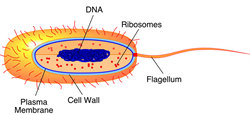
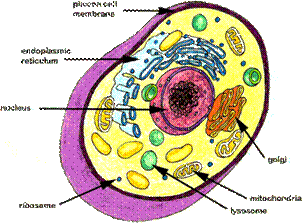
Eukaryotic cell-animal cell
Eukaryotic cell- Plant cell
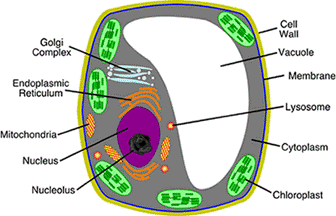
Take in energy assimilation of materials respond to stimuli
2. Carrier Protein
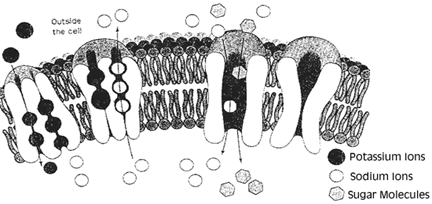
1.
Cell Part |
Function |
Mitochondria |
Energy center or "powerhouse" of the cell. Turns food into useable energy (ATP). This is the site for Cellular Respiration. |
Ribosomes |
Make protein |
Golgi apparatus |
Processes, packages and secretes proteins (cell’s post office) |
Lysosomes |
Contains digestive enzymes, breaks things down |
ER (Endoplasmic reticulum) |
Transport, "intracellular highway" |
Vacuole |
Stores water or other substances (Plants- 1 large one Animals-several small ones. |
Chloroplast |
Uses sunlight to create food, site of photosynthesis (only found in plant cells) |
Cell wall |
Provides additional support (plant, fungi, and bacteria cells) |
Cytoplasm |
Jelly-like fluid interior of the cell |
Nucleus |
the "control center" of the cell, contains the cell's DNA (chromosomes) |
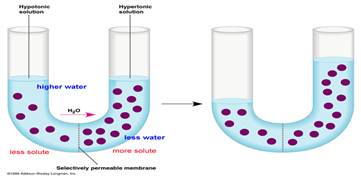
This solution would be __Isotonic____________.
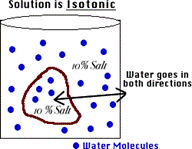
This solution would be __Hypotonic________.
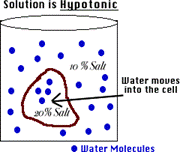
This solution would be ___Hypertonic_____.
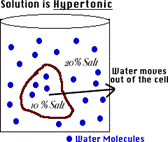
14. 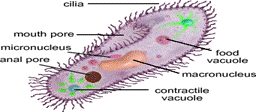 The contractile vacuole inside of some protists like the paramecium above maintains osmotic balance by pumping out excess ____water_____________.
The contractile vacuole inside of some protists like the paramecium above maintains osmotic balance by pumping out excess ____water_____________.
15. _Active___________ is the type of transport which requires energy.
16. Bulk transport into the cell is known as ___endocytosis________, and bulk transport out of the cell is known as ____exocytosis________.
17. ____Enzymes_______ are special proteins that speed up the rate of chemical reactions.
18. The __substrate___________ is the substance an enzyme acts upon.
.
19. Label the diagram below with the following terms: Enzyme/substrate complex, substrate, enzyme, products.
e/s complex_
__products__________
__enzyme
_substrate______________
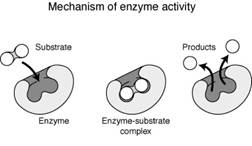
20. If you see a word that ends in –ase, it is probably an ___enzyme______, and if a word ends in –ose it is a ___sugar__________.
21. The area in which a substrate molecule fits into an enzyme is known as the __active site__.
22. Fill in the table on the 4 major biomolecules
Biomolecule |
Monomer |
Function |
1. Carbohydrate |
monosaccharide |
Provide nrg |
2. Lipid |
Glycerol and fatty acids |
Stored nrg |
3.Protein |
Amino acids |
Some are important structural components of living things- some serve as enzymes . |
4. Nucleic acids |
nucleotides |
Carry hereditary info. |
23. ATP-Adenosine Triphosphate is a special molecule that stores and releases the energy in its bonds when the cell needs it. Below is a diagram showing the ATP-ADP cycle. On the lines beside the diagram write either energy released for chemical reactions or energy supplied through cellular respiration.
Nrg supplied
_thru___cellular___resp.___
Nrg released
_for___chem..___rxns______

ADP + P
24. The process in which plants utilize sunlight energy into chemical energy in the form of glucose is called ___photosynthesis________________________.
25. The process above takes place in the _chloroplast_____________ of the plant cell.
26. Fill in the summary reaction for photosynthesis below with the correct reactants and products. Use the following terms: water, carbon dioxide, glucose, oxygen, CO2, H2O, C6H12O6, O2 (Place symbols on the top lines and words on the bottom.)
sunlight
![]() _6H2O_____ + _6CO2___ _C6H1206_ + __6O2______
_6H2O_____ + _6CO2___ _C6H1206_ + __6O2______
water______ carbon dioxide glucose____ ___oxygen_______
27. The process by which organisms break down glucose in order to release the energy in it is known as ___cellular respiration________.
28. This process takes place in the ___mitochondria________ of the cell.
29. Fill in the summary reaction for cellular respiration below with the correct reactants and products. Use the following terms: water, carbon dioxide, glucose, oxygen, CO2, H2O, C6H12O6, O2 (Place symbols on the top lines and words on the bottom.)
![]() 6O2____ + __C6H12O6____ __6CO2____ + ____6H2O___
6O2____ + __C6H12O6____ __6CO2____ + ____6H2O___
oxygen glucose Carbon dioxide water
30._Taxonomy_________ is the branch of biology which deals with the grouping and naming of organisms.
31. Carolus Linneaus developed the two word system to name organisms known as _binomial nomenclature_.
32. The first word of a scientific name is the ___genus_________ name and the second word is the __species_____ name.
33. There are __7___________ taxa (classification categories) in Linneaus’ system. List them in order from smallest to largest.
1. Species King Philip Came Over From Germany Singing
2. Genus
3. Family
4. Order
5. Class
6. Phylum
7. Kingdom
34. In the modern day classification system there are __6_____ kingdoms and ____3____ domains. Eukarya, Bacteria, Archaea
35. Correctly identify the kingdoms given the descriptions in the table below. Provide an example organism in each kingdom.
Kingdom |
Description |
Example Organism |
FUNGI |
Consumers that stay put. They have eukaryotic cells. They may be unicellular or multicellular. They decompose dead organisms and waste from the environment. |
What is the only single celled organism in this group? |
PLANTAE |
Multicellular eukaryotes that photosynthesize. Have cellulose cell walls. |
Grass, flowers, tree, cacti, |
ARCHAEBACTERIA |
Mainly found in extreme environments. Some of these prokaryotic cells like extremely hot temperatures and areas of high salt content. |
HalophilesThermophiles |
ANIMALIA |
Multicellular consumers. They do not contain cell walls. Most have the ability to move. |
Mammals, reptiles, insects, fish, worms, birds, |
PROTISTA |
Most diverse kingdom of organisms. They may be unicellular or multicellular. They live in moist environments. Some are plant-like, some animal-like, some fungus-like. |
Algae, Protozoa, Slime molds |
EUBACTERIA |
This group of prokaryotes can be both beneficial and harmful. Some cause diseases while others are used in the food industry and are decomposers. |
Salmonella, E.coli, Staph, |
36. Match the animal phylum characteristics with the correct phylum name:
_e___Contain no specialized tissue; Have many pores. A. Platyhelminthes
_f___ Bodies with radial symmetry. Stinging cells B. Chordata
_a___ Flat worms; Only one body opening for digestive tract C. Nematoda
_c___ Round worms; First group with 2 body openings D. Arthropoda
__g_ Segmented worms. First group with complete Digestive E. Porifera
system F. Cnidaria
__i__ snails, squid, clams, oysters, slugs; Soft-body G. Annelida
_d___ Jointed appendages and exoskeletons; H. Echinodermata
_h___ spiny skin I. Mollusa
_b___ notochord, gill slits, tail
37. In the table below, write in the correct Vertebrate class.
Class |
Description |
Amphibia |
Must return to water to reproduce. Obtain oxygen with gills when young and with lungs and through skin as an adult. |
Aves (birds) |
Have hollow bones and feathers. |
Agnatha : Myxini |
Are jawless fish with skeletons made of cartilage. |
Chondrichthyes |
Cartilaginous fishes; |
Reptilia |
The first group to produce an amniotic egg. Have tough scaly skin. |
Mammalia |
Feed their young milk. Have hair as a body covering |
Osteichthyes |
Bony fishes |
38. Organism that can maintain a constant body temperature regardless of external temperature are known as __endothermic________. Also known as warm-blooded.
39. Organisms whose body temperature is similar to the temperature of the environment are known as __ectothermic____________. Also known as cold-blooded.
40.___Bryophytes___________ plants have no vascular tissue, no roots, stems, or leaves. Ex. Mosses, hornworts, and liverworts.
41. ___Tracheophytes_________ plants have vascular tissue to transport food and water.
Ex. Ferns, grass, trees, bushes, etc….
42. The type of vascular tissue that conducts water from the roots to the leaves is known as ___xylem______________.
43. The type of vascular tissue that conducts sugar from the leaves to the roots is known as ___phloem____________.
44. Label the flower below using the following terms: Petal, Pistil, stamen, ovary, ovule, sepal D P H L O
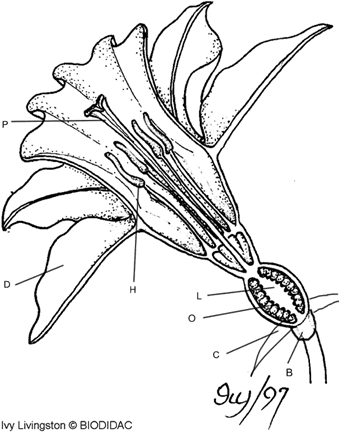
45. Label the 3 parts of the pistil, and the 2 parts of the stamen in the drawings below.


46. The __cuticle_____ is a waxy substance that reduces water loss in plants.
47. _Stomata____ are openings in the epidermis of a leaf that allows for gas exchange and transpiration.
Content Domain III: Genetics.
48. Chromosomes are made up of the organic molecules called ____Nucleic________acids. (DNA)
49. There are 2 kinds of nucleic acids ____DNA______ and __RNA______.
50. How do these 2 kinds differ?
1. Different sugars (DNA: Deoxyribose, RNA: Ribose)
2. # of strands (DNA double stranded, RNA single stranded)
3. Types: (DNA: 1 type, RNA: 3 types)
4. N bases (DNA: ATCG, RNA: AUCG)
51. List the four kinds of nitrogenous bases found in the DNA molecule showing which bonds to which. (A-T, C-G)
52. List the four kinds of nitrogenous bases found in the RNA molecule showing which bonds to which. (A-U, C-G)
53. Name the 3 kinds of RNA ___mRNA_(messenger), ___tRNA_(transfer)___, and ____rRNA__(ribosomal)___. Know the function of each.
54. The DNA molecule has the shape of a _____twisted ladder ___________.
55. The RNA molecule is __single________ stranded.
56. The process by which DNA makes a copy of itself is known as ___replication_____ and it takes place during __Interphase__________ of the cell cycle.
57. Where does the above process take place in the cell?___nucleus__________
58. The process of protein synthesis occurs in 2 stages. __Transcription_______ is the first stage and must take place in the nucleus. ___Translation__________________ is the second stage and occurs on ribosomes in the cytoplasm.
59. If the sequence of codons on an mRNA are ACGAACCUUAGG, what would the ones on the DNA have been?______ ______ TGCTTGGAATCC
60. What does a codon on the RNA molecule code for?__an Amino acid_____
61.Humans have _46____ chromosomes in every body cell. This is known as the _diploid____ number and is abbreviated by 2N.
62. Humans have _23____ chromosomes in their sex cells. This is known as the _haploid________ number and is abbreviated by N.
63. Cells divide by the process of _mitosis & cytokinesis (cell division) for growth and repair.
64. List the 4 phases of the above cell division in order.
1._prophase_______ 2. __metaphase______ 3. _anaphase____ 4.___telophase_____
65.During which phase do the chromosomes line up in the middle?____Metaphase___
66. During which phase do replicated chromosomes separate from each other?_____Anaphase_____
67. The division of the cytoplasm of the cell is known as cytokinesis. How does this differ between plant and animal cells? (An: furrow forms & pinch cell in two) (Pl: cw form & divide the two)
68. Another name for sex cells is ___gametes (reprod. cells)____.
69. Meiosis is different from mitosis in that in meiosis __4__________daughter cells are formed instead of ___2__________ as in mitosis. Also in meiosis the chromosome number is _reduced______ from diploid to haploid. What is the diploid number for humans?__46_______
70. The male gamete is the sperm____ and the female gamete is the __egg____________.
71. Chromosomes come in pairs known as __homologous pairs___________.
72. During meiosis, when these pairs don’t separate properly, genetic disorders can occur. This failure to separate is known as ____nondisjunction____________________.
73. The karyotype below illustrates what would happen if this mutation occurred. What type of disorder would this individual have? What is the sex of the individual? Down Syndrome; Female
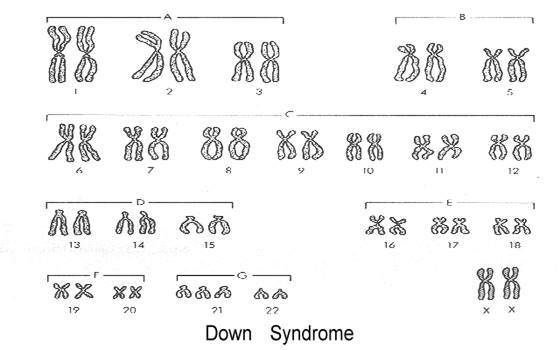
74. What occurs to the homologous pairs in prophase 1 of meiosis that gives us genetic variation?___crossing over_____________
75. Reproduction involving one parent is known as ___asexual _________ reproduction.
76. Budding, vegetative propagation, and binary fission are all types of __asexual reprod.______.
77. The study of inheritance is known as _____Genetics________________.
78. An Austrian monk named____Mendel___________________ is known as the father of genetics.
79. He explained the principles of dominance, independent assortment and segregation. Name the plant he used to make crosses to discover these principles.__pea plants_____
80. The __Punnett___ square is used to determine the outcome of a genetic cross.
81. Cross a homozygous tall plant with a short plant. Tall is dominant. What would the genotype of the tall plant be _TT___? What would the genotype of the short plant be_tt_?
Tt
|
What would be the phenotype of all the offspring? tall |
Tt
|
Tt |
82. If you cross a red flower and a white flower all the offspring are pink. This is an example of ____incomplete dominance_____.
83. Blood type is an example of codominance. __A______ and __B______ are both dominant and ___O______ is recessive.
84. Choose a word from the list below to complete the following paragraph.
Ecology, habitat, niche, biome, limiting factors, predator, prey, decomposers, photosynthesis, symbiosis, parasitism, mutualism, commensalism, succession, primary succession, secondary succession, pioneer, ecosystem, food chain, food pyramid, carrying capacity, food web, abiotic, biotic, heterotrophs, autotrophs, carnivore, herbivore, biomass, 10%, 90%, climax community
__Ecology_______ is the branch of biology that studies the interaction of living organisms in their environments. The living things are called __biotic_______ factors and the non-living factors such as wind, air, water, soil, etc. are the ___abiotic______ factors. Where an organism lives such as an owl in a tree is its __habitat_______ and the job the organism has in the environment is its __niche______. An owl’s niche would be that of a _predator________. The mouse an owl eats would be a __prey___________. This relationship plus what the mouse eats could be shown in a __food chain_____ ____________. If several food chains intertwine showing many feeding relationships and energy flow you would have a _food web___________. If the flow of energy is shown in a food or energy pyramid, which kinds of organisms normally form the base of the pyramid?_producers (autotrophs)__(producers or consumers). How much energy is available for the next level?_10%______. The total amount of living matter produced in an environment is called its___biomass_______. All of the biotic and abiotic factors interacting in an area form a(n) ___ecosystem__________. An area characterized by a dominant climate and plant/animal life is known as a __biome________. Plants & Algae are the only organisms that can convert sunlight into chemical energy in the form of carbohydrates. Plants are the _Producers___________ or __autotrophs_______ and the animals and fungi are the _consumers______________ or __heterotrophs_____.The process by which plants trap the energy from sunlight to make glucose or other sugars is known as___Photosynthesis________. Organisms that break down dead organic matter and return nutrients to the soil are called __Decomposers (saprobes/saprophytes)____. Sometimes two organisms live together in a relationship known as __symbiosis____. If both organisms benefit from the relationship such as in lichens, the relationship is called __mutualism________, but if one organism is harmed due to the relationship it is called ___parasitism_______. All organisms require things in order to live. When these things are not available, they cannot reproduce or stay alive. These factors are called the _limiting________factors. They could include space, food, nutrients, water, etc. When an area has reached the maximum capacity of individuals, it is said to be at ___carrying capacity____________. The gradual change of an ecosystem or environment to a different kind of environment is known as __succession___________. When it occurs after a fire, hurricane, or other natural disaster it is known as ___secondary____, but when it occurs where there has never been any life before it is called __primary_________. The first plants, such as lichens, mosses, and ferns to live on bare rock or ground are called pioneer ____plants. The stable community containing mostly hardwood trees would be known as __climax community__________.
85. ___Darwin______________ was an English naturalist who traveled to the _____Galapagos______ islands making careful notes and descriptions of the organisms there such as tortoises and finches?
86. His theory of _natural selection (survival of the fittest)__ stated that organism who were well suited to the environment would survive and pass on their traits to their offspring.
87. Favorable variations within a species that allow them to be well suited to the environment are known as ___adaptations____.
88. The finches below show similar birds with variations in beaks and eating habits. This could have been a result of __Adaptive_____ radiation.
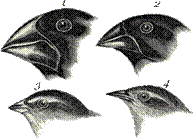
89. The diagram below shows anatomical evidence for evolution. These structures are known as __Homologous_____________structures.
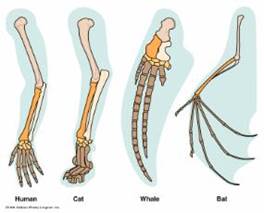
90. __Convergent____ evolution occurs when two unrelated species have similar form.
91
. Would breeding race horses be an example of artificial or natural selection?__artificial______________
92. _Fossil______ or the traces of organisms that once lived are also evidence for evolution.
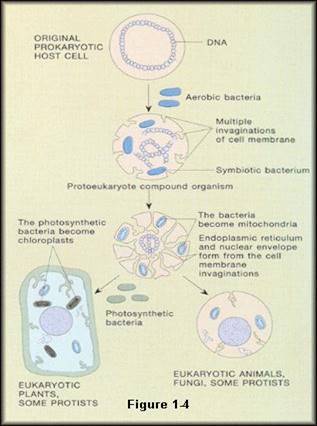 93. The diagram to the right illustrates the theory
93. The diagram to the right illustrates the theory
of how eukaryotes evolved from prokaryotes. This
theory is known as _Endosymbiont theory__.
(Lynn Margulis)
(ex. appendix, earlobes, etc.)
Source: http://www.effinghamschools.com/cms/lib4/GA01000314/Centricity/ModuleInstance/6375/Biology_EOCT_Answers.docx
Web site to visit: http://www.effinghamschools.com
Author of the text: not indicated on the source document of the above text
If you are the author of the text above and you not agree to share your knowledge for teaching, research, scholarship (for fair use as indicated in the United States copyrigh low) please send us an e-mail and we will remove your text quickly. Fair use is a limitation and exception to the exclusive right granted by copyright law to the author of a creative work. In United States copyright law, fair use is a doctrine that permits limited use of copyrighted material without acquiring permission from the rights holders. Examples of fair use include commentary, search engines, criticism, news reporting, research, teaching, library archiving and scholarship. It provides for the legal, unlicensed citation or incorporation of copyrighted material in another author's work under a four-factor balancing test. (source: http://en.wikipedia.org/wiki/Fair_use)
The information of medicine and health contained in the site are of a general nature and purpose which is purely informative and for this reason may not replace in any case, the council of a doctor or a qualified entity legally to the profession.
The following texts are the property of their respective authors and we thank them for giving us the opportunity to share for free to students, teachers and users of the Web their texts will used only for illustrative educational and scientific purposes only.
All the information in our site are given for nonprofit educational purposes
The information of medicine and health contained in the site are of a general nature and purpose which is purely informative and for this reason may not replace in any case, the council of a doctor or a qualified entity legally to the profession.
www.riassuntini.com